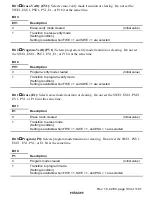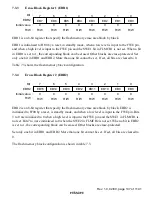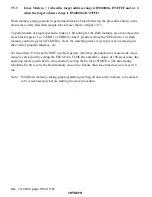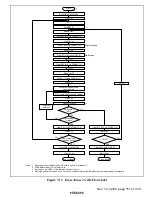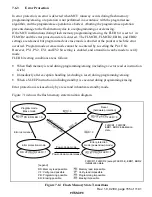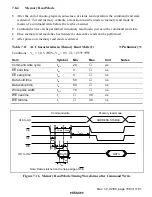
Rev. 1.0, 02/00, page 147 of 1141
7.5
Programming/Erasing Flash Memory
In the on-board programming modes, flash memory programming and erasing is performed by
software, using the CPU. There are four flash memory operating modes: program mode, erase
mode, program-verify mode, and erase-verify mode. With addresses H'00000 to H'3FFFF,
transitions to these modes can be made by setting the PSU1, ESU1, P1, E1, PV1 and EV1 bits in
FLMCR1. With addresses H'40000 to H'47FFF, transitions to these modes can be made by setting
the PSU2, ESU2, P2, E2, PV2, and EV2 bits in the FLMCR2.
The flash memory cannot be read while being programmed or erased. Therefore, the program that
controls flash memory programming/erasing (the programming control program) should be
located and executed in on-chip RAM or external memory.
Notes: 1. Operation is not guaranteed if setting/resetting of the SWE1, ESU1, PSU1, EV1, PV1,
E1, and P1 bits in FLMCR1, and the SWE2, ESU2, PSU2, EV2, PV2, E2, and P2 in
FLMCR2, is executed by a program in flash memory.
2. When programming or erasing, set FWE to 1 (programming/erasing will not be
executed if FWE = 0).
3. Perform programming in the erased state. Do not perform additional programming on
previously programmed addresses.
4. Do not write to addresses H'00000 to H'3FFFF and H'40000 to H'47FFF at the same
time. Otherwise operation cannot be guaranteed.
5. Do not operate the OSD when writing or erasing addresses H'40000 to H'47FFF. Do
not set the OSROME in STCR to 1 before manipulating the flash control register.
7.5.1
Program Mode (n=1 when the target address range is H'00000 to H'3FFFF and
n=2 when the target address range is H'40000 to H'47FFF)
Follow the procedure shown in the program/program-verify flowchart in figure 7.12 to write data
or programs to flash memory. Performing program operations according to this flowchart will
enable data or programs to be written to flash memory without subjecting the device to voltage
stress or sacrificing program data reliability. Programming should be carried out 128 bytes at a
time.
Following the elapse of 1.0
µ
s or more after the SWEn bit is set to 1 in flash memory control
register n (FLMCRn), 128-byte program data is stored in the program data area and reprogram
data area, and the 128-byte data in the reprogram data area written consecutively to the write
addresses. The lower 8 bits of the start address written to must be H'00, or H'80. One hundred
and twenty-eight consecutive byte data transfers are performed. The program address and
program data are latched in the flash memory. A 128-byte data transfer must be performed even if
writing fewer than 128 bytes; in this case, H'FF data must be written to the extra addresses.
Next, the watchdog timer is set to prevent overprogramming in the event of program runaway, etc.
Set 6.6 ms as the WDT overflow period. After this, preparation for program mode (program
setup) is carried out by setting the PSUn bit in FLMCRn, and after the elapse of 50
µ
s or more, the
operating mode is switched to program mode by setting the Pn bit in FLMCRn. The time during

